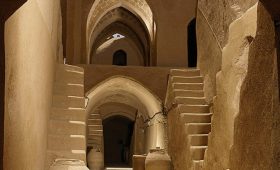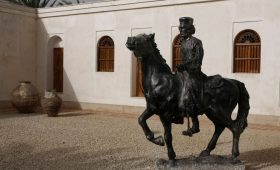The design of Sheikh Lotfollah Mosque was put into operation at a time when the plan of four gardens and a thousand-acre garden was being implemented and was in a period when Safavid architecture was flourishing. The construction of this mosque in the first half of the eleventh century AH, in 1011 AH (1602 AD) and began by order of Shah Abbas I and ended in 1028 AH (1619 AD). The construction of this mosque took eighteen years.
The architect of this mosque was Master Mohammad Reza Isfahani, the son of Master Hossein Bana Isfahani. This mosque was built on the ruins of a mosque that used to be there. Sheikh Lotfollah Mosque is named after one of the great scholars of the Safavid era, Sheikh Lotfollah Jabal Ameli. Sheikh Lotfatullah was one of the great scholars of the Safavid period. He was a resident of Jabal Amel in Lebanon who, like Sheikh Baha’i and some other scholars, emigrated from Lebanon to Iran by Shah Abbas and first settled in Mashhad and Qazvin and then in Isfahan. Because the Safavid government was a religious government and valued Islam, especially the Shiite religion, it also honored its scholars. On the other hand, Sheikh Lotfatullah was the father-in-law of Shah Abbas. Therefore, a mosque and a school named after him were built in the Sheikh’s place of residence, where he taught jurisprudence lessons and religious meetings.
The tile decorations of Sheikh Lotfollah Mosque are all covered with mosaic tiles inside from the plinths upwards. This mosque is one of the most beautiful historical monuments of Isfahan, located on the eastern side of Naghsh Jahan Square, in front of Aali-Qapo Mansion. A number of mosaic tiles inside and outside the dome and the inscriptions of its third line are in the line of Ali Reza Tabrizi Abbasi.
This mosque is not similar to other mosques because it has no minaret and no entrance nave (courtyard) and its entrance has stairs. The lack of a nave and entrance courtyard leads the mosque to the symmetrical requirements of Naghsh Jahan Square (the location of the mosque facing the Aali Qapo mansion), which ultimately leads to the issue of not being able to use the courtyard or courtyard facing the qibla for worship. It designed.
The architectural style of this building is in the Isfahani style. The front of the mosque begins with a retreat from the eastern body of the square. After crossing the four steps, we reach the entrance area. The lower part of the walls of this area is covered with yellow marble, and the large side platforms are of the same type of stone. The entrance of the mosque is in the form of two lintels, which are made of monolithic sycamore wood and are still standing after four hundred years. In front of the mosque, there is a beautiful octagonal pool that was removed in the years 1316 to 1318 AH. At this time, the floor covering of the dome was made of plaster and the wooden windows installed in it provided the lighting of the basement. Sheikh Lotfallah Mosque has no courtyard.
The mosaic head was built and polished until the end of 1011 AH, and the building and its decorations were completed in 1028 AH. The inscription on the head is in the third line of Alireza Abbasi and is dated to 1012 AH. He was the architect and builder of the mosque of Ustad Mohammad Reza Isfahani. His name is mentioned inside the beautiful altar of the mosque in two small tablets. Bana Esfahani 1028 Lines and inscriptions inside the work mosque of Alireza Abbasi. Inside and outside the dome, unlike this building, which is considered one of the most beautiful domes in the world, it is covered with exquisite mosaic tiles. Foreign archaeologists have praised the architectural grandeur of the mosque. The use of natural light and beautiful colors are all among the striking features of this building.
One of the unique architectural masterpieces can be seen in the altar of Sheikh Lotfollah mosque. In this altar, very delicate mosaic tiles and moqarnas can be seen and there are also two tablets inside the altar on which the phrase “poor humble deed in need of God’s mercy Mohammad Reza Ibn Ustad Hussein Banai of Isfahan” is engraved. Other inscriptions in the script of Alireza Abbasi can be seen around the altar, on which a narration of the Holy Prophet and the sixth Imam has been narrated. In addition to these narrations, poems have also been written on the inscriptions, which according to experts are composed by “Sheikh Baha’i”, a scientist and poet of the Safavid period. The calligrapher of these inscriptions is also Baqir Banna. The altar is very attractive due to its clean and smooth color, as well as its composition and coordinated lines. The altar consists of a serrated arch on which delicate Islamic motifs are engraved. This concave arch has shell-shaped moqarnas inside, which are decorated with beautiful plant motifs at the end.




